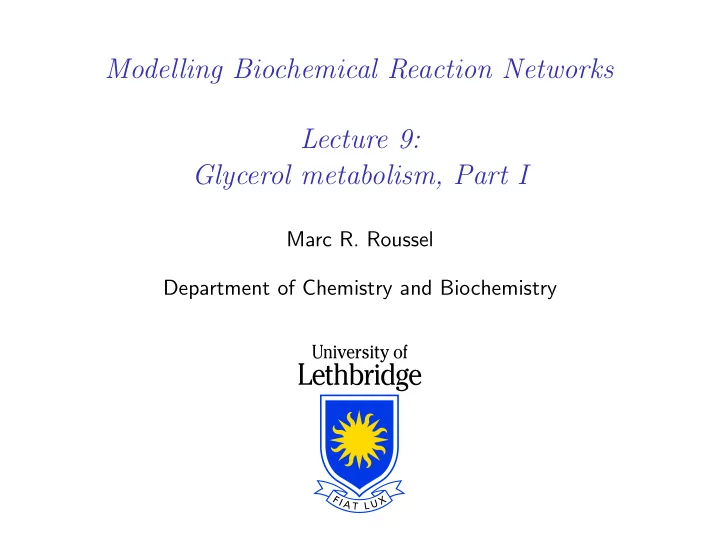

Modelling Biochemical Reaction Networks Lecture 9: Glycerol metabolism, Part I Marc R. Roussel Department of Chemistry and Biochemistry
Glycerol metabolism ◮ Glycerol is one of the building blocks of lipids. ◮ Used as an energy source by conversion to a form that can be injected into the glycolytic pathway: glycerol dihydroxyacetone glyceraldehyde glycerol 3−phosphate phosphate 3−phosphate H O CH OH CH 2 OH CH 2 OH ATP ADP + + 2 NAD NADH + H C HO C H HO C H O C H C OH glycerol glycerol triose phosphate kinase 3−phosphate isomerase 2− 2− dehydrogenase C H 2 O H CH 2 PO CH 2 PO 4 2− 4 CH 2 PO 4 glycolysis
Flux through a pathway ◮ Rate at which material “moves through” a pathway ◮ To define a flux, need a “source” and a “sink” ◮ Options for a source: ◮ Constant glycerol ◮ Constant rate of addition of glycerol ◮ Options for a sink: ◮ Neglect reversibility of triose phosphate isomerase and make D-glyceraldehyde 3-phosphate the sink ◮ Include one or more reactions from glycolysis, the last of which is irreversible (in reality or by assumption)
Questions ◮ Glycerol is a byproduct of various industrial processes (production of soap, biodiesel, vegetable oil). ◮ We might want to use it as a feedstock for production of (e.g.) yeast, for baking, brewing/fermenting, or sometimes used as nutritional supplements for cattle. ◮ What factor(s) limit the flux through this pathway? ◮ Can we engineer a strain of Saccharomyces cerevisiae that is capable of a higher flux through this pathway?
Glycolysis “payoff phase” ◮ We have to be careful not to “choke” glycolysis, so we should model the relevant part of this pathway, the so-called “payoff phase”: glyceraldehyde 1,3−bisphosphoglycerate 3−phosphoglycerate 2−phosphoglycerate 3−phosphate 2 − H O O O − O O − PO O 4 C NAD + + C ADP ATP C C NADH + H 2− H C OH H C OH H C OH H C PO 4 glyceraldehyde phosphoglycerate phosphoglycerate 3−phosphate kinase mutase 2− 2− 2− dehydrogenase CH PO CH PO C H PO HO C H 2 4 2 4 2 4 2 enolase O O − O O − C C ATP ADP 2− C O H C PO 4 pyruvate kinase C H C H 3 2 pyruvate phosphoenolpyruvate
Cosubstrates ◮ Several reactions have cosubstrates (ATP, ADP, NAD + , etc.). ◮ Treat as constant using typical in vivo values ◮ Resource: K. R. Albe et al., J. Theor. Biol. 143 , 163 (1990). ◮ Must know rate law, which depends on order of binding and other details ◮ Issue can sometimes be ducked, depending on how parameters were measured
Locating enzyme parameters ◮ We need (a) rate law, (b) K M for each substrate, and (c) v max or (d) k cat and [E] total ( v max = k cat [E] total ). ◮ Preferably need parameters for each enzyme from our target organism ◮ Useful resource: BRENDA, a database of enzyme kinetic parameters ( http://www.brenda-enzymes.org ) Example: glycerol kinase
Estimating the kinetic parameters of glycerol kinase in S. cerevisiae ◮ K M (glycerol) = 2 mM [C. C. Aragon et al., J. Mol. Catal. B 52–53 , 113 (2008)] ◮ BRENDA gives values of the turnover number ( k cat ) and of the specific activity ( v max / c E , where c E is the concentration of enzyme in g/L) ◮ Either way, need enzyme concentration to get v max ◮ No values given for S. cerevisiae
Estimating the kinetic parameters of glycerol kinase in S. cerevisiae ◮ It would be unusual to measure a K M without also obtaining a v max , so go look at Aragon et al. (2008). ◮ v max = 1 . 15 U / mL ◮ Methods, section 2.5: “One unit (U) of enzyme was defined as the amount of the enzyme catalyzing the formation of 1 µ mol of glycerol-3-phosphate/min at 60 ◦ C.” ◮ v max = 1 . 15 µ mol (mL) − 1 min − 1 ≡ 19 . 2 µ mol L − 1 s − 1 Problem: Data given at 60 ◦ C, not the 20–30 ◦ C of industrial processes Rule of thumb: Rate constants approximately double for every 10 ◦ C increase in temperature ◮ v max at 20 ◦ C should be about 2 4 times smaller than at 60 ◦ C, or about 1 µ mol L − 1 s − 1 .
Estimating the kinetic parameters of glycerol kinase in S. cerevisiae ATP as cosubstrate ◮ Issue not addressed by Aragon et al. (2008) ◮ Assays carried out in presence of a roughly physiological concentration of ATP (2.6 mM, somewhat higher than the 1–2 mM usually found in yeast; Albe et al., 1990) ◮ Get effective rate law for that concentration of ATP ◮ Given uncertainties in other parameters, this should be OK.
Estimating the kinetic parameters of glycerol kinase in S. cerevisiae Summary v max [glycerol] v gk = K gk + [glycerol] with v max = 1 µ mol L − 1 s − 1 K gk = 2 mM
Next time ◮ We could continue in this vein, and in some cases we have no other choice. ◮ Next time: another key resource that allows us to build on other people’s work
Recommend
More recommend